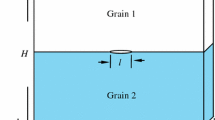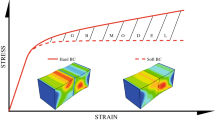Abstract
Atomistic simulations of tensile straining of three-dimensional nanocrystalline palladium samples at room temperature and at a constant strain rate of \(10^{8}\,\hbox {s}^{-1}\) were performed. Potential understating surface energies and therefore facilitating intergranular fracture was applied for modeling of interatomic interactions. Palladium samples subjected to uniaxial straining have demonstrated initiation of intergranular cracks which have occurred preferably at the high-angle grain boundaries oriented perpendicular to the direction of applied strain and independently of their tilt/twist character. Further propagation of cracks took place along the adjacent grain boundaries. No cases of intergranular fracture at low-angle grain boundaries, of both the general and special character, were found. Intergranular fracture was observed only in an insignificant number of special high-angle grain boundaries.





Similar content being viewed by others
References
Abadi R, Uma RP, Izadifar M, Rabczuk T (2016) The effect of temperature and topological defects on fracture strength of grain boundaries in single-layer polycrystalline boron-nitride nanosheet. Comput Mater Sci 123:277–286
Alexandreanu B, Capell B, Was GS (2001) Combined effect of special grain boundaries and grain boundary carbides on IGSCC of Ni–16Cr–9Fe–xC alloys. Mat Sci Eng A Struct 300:94–104
Arafin MA, Szpunar JA (2009) A new understanding of intergranular stress corrosion cracking resistance of pipeline steel through grain boundary character and crystallographic texture studies. Corros Sci 51:119–128
Bachurin DV (2018a) Influence of internal stresses on deformation behavior of nanocrystalline palladium. Mat Sci Eng A Struct 734:255–259
Bachurin DV (2018b) Influence of voids distribution on the deformation behavior of nanocrystalline palladium. Solid State Commun 275:43–47
Bachurin DV, Gumbsch P (2010) Accommodation processes during deformation of nanocrystalline palladium. Acta Mater 58:5491–5501
Bachurin DV, Gumbsch P (2012) Elastic and plastic anisotropy after straining of nanocrystalline palladium. Phys Rev B 85:085407
Bachurin DV, Gumbsch P (2014) Atomistic simulation of the deformation of nanocrystalline palladium: the effect of voids. Model Simul Mater Sc 22:025011
Bond DM, Zikry MA (2018) Differentiating between intergranular and transgranular fracture in polycrystalline aggregates. J Mater Sci 53:5786–5798
Brandon DG (1966) Structure of high-angle grain boundaries. Acta Metall Mater 14:1479
Coffman VR, Sethna JP (2008) Grain boundary energies and cohesive strength as a function of geometry. Phys Rev B 77
Farkas D, Nogueira R, Ruda M, Hyde B (2005a) Atomistic simulations of the effects of segregated elements on grain-boundary fracture in body-centered-cubic Fe. Metall Mater Trans A 36A:2067–2072
Farkas D, Van Petegem S, Derlet PM, Van Swygenhoven H (2005b) Dislocation activity and nano-void formation near crack tips in nanocrystalline Ni. Acta Mater 53:3115–3123
Fensin SJ, Valone SM, Cerreta EK, Gray GT (2012) Influence of grain boundary properties on spall strength: grain boundary energy and excess volume. J Appl Phys 112:083529
Field DP, Adams BL (1992) Interface cavitation damage in polycrystalline copper. Acta Metall Mater 40:1145–1157
Geraci G, Aliabadi MH (2017) Micromechanical boundary element modelling of transgranular and intergranular cohesive cracking in polycrystalline materials. Eng Fract Mech 176:351–374
Gertsman VY, Bruemmer SM (2001) Study of grain boundary character along intergranular stress corrosion crack paths in austenitic alloys. Acta Mater 49:1589–1598
Ikeda K, Morita K, Nakashima H, Abe H (1999) Misorientation dependence of grain boundary fracture strength and grain boundary energy for molybdenum \(<001>\) symmetric tilt boundaries. J Jpn I Met 63:179–186
Kedharnath A, Panwar AS, Kapoor R (2017) Molecular dynamics simulation of the interaction of a nano-scale crack with grain boundaries in alpha-Fe. Comput Mater Sci 137:85–99
Kim T, Hong KT, Lee KS (2003) The relationship between the fracture toughness and grain boundary character distribution in polycrystalline NiAl. Intermetallics 11:33–39
Kobayashi S, Tsurekawa S, Watanabe T (2016) A new approach to grain boundary engineering for nanocrystalline materials. Beilstein J Nanotech 7:1829–1849
Kraft RH, Molinari JF (2008) A statistical investigation of the effects of grain boundary properties on transgranular fracture. Acta Mater 56:4739–4749
Kurishita H, Kuba S, Kubo H, Yoshinaga H (1985a) Misorientation dependence of grain-boundary fracture in molybdenum bicrystals with various (110) twist boundaries. T Jpn I Met 26:332–340
Kurishita H, Oishi A, Kubo H, Yoshinaga H (1985b) Grain-boundary fracture in molybdenum bicrystals with various (110) symmetric tilt boundaries. T Jpn I Met 26:341–352
Lehockey EM, Palumbo G (1997) On the creep behaviour of grain boundary engineered nickel. Mat Sci Eng A Struct 237:168–172
Li J (2003) AtomEye: an efficient atomistic configuration viewer. Model Simul Mater Sc 11:173–177
Lin H, Pope DP (1993) The influence of grain-boundary geometry on intergranular crack-propagation in Ni3Al. Acta Metall Mater 41:553–562
Lin H, Pope DP (1995) Weak grain-boundaries in Ni3Al. Mat Sci Eng A Struct 192:394–398
Lin LQ, Wang XQ, Zeng XW (2017) The role of cohesive zone properties on intergranular to transgranular fracture transition in polycrystalline solids. Int J Damage Mech 26:379–394
Nazarov AA, Mulyukov RR (2003) Handbook of nanoscience, engineering, and technology. CRC Press, Boca Raton
Pan Y, Adams BL, Olson T, Panayotou N (1996) Grain-boundary structure effects on intergranular stress corrosion cracking of Alloy X-750. Acta Mater 44:4685–4695
Pioszak GL, Gangloff RP (2017) Hydrogen environment assisted cracking of modern ultra-high strength martensitic steels. Metall Mater Trans A 48A:4025–4045
Qian J, Li SF (2011) Application of multiscale cohesive zone model to simulate fracture in polycrystalline solids. J Eng Mater T Asme 133:011010
Qiu RZ, Li CC, Fang TH (2017) Mechanical properties and crack growth behavior of polycrystalline copper using molecular dynamics simulation. Phys Scr 92:085702
Rath BB, Bernstein IM (1971) Relation between grain-boundary orientation and intergranular cracking. Metall Trans 2:2845–2851
Scheiber D, Pippan R, Puschnig P, Romaner L (2016) Ab initio calculations of grain boundaries in bcc metals. Model Simul Mater Sc 24:035013
Schiotz J, Vegge T, Di Tolla FD, Jacobsen KW (1999) Atomic-scale simulations of the mechanical deformation of nanocrystalline metals. Phys Rev B 60:11971–11983
Shenderova OA, Brenner DW, Omeltchenko A, Su X, Yang LH (2000) Atomistic modeling of the fracture of polycrystalline diamond. Phys Rev B 61:3877–3888
Shenderova OA, Brenner DW, Omeltchenko A, Su X, Yang LH, Nazarov AA (1999) Multiscale modeling of polycrystalline diamond. In: Proceedings of the second international conference on the modeling and simulation of microsystems, actuators and sensors, pp. 61–64
Somekawa H, Singh A, Inoue T, Mukai T (2010) Enhancing fracture toughness of magnesium alloy by formation of low-angle grain boundary structure. Adv Eng Mater 12:837–842
Spearot DE, Tschopp MA, Jacob KI, McDowell DL (2007) Tensile strength of \(<100>\) and \(<110>\) tilt bicrystal copper interfaces. Acta Mater 55:705–714
Su JQ, Demura M, Hirano T (2002) Grain-boundary fracture strength in Ni3Al bicrystals. Philos Mag A 82:1541–1557
Sukumar N, Srolovitz DJ, Baker TJ, Prevost JH (2003) Brittle fracture in polycrystalline microstructures with the extended finite element method. Int J Numer Math Eng 56:2015–2037
Tanaka T, Tsurekawa S, Nakashima H, Yoshinaga H (1994) Misorientation dependence of fracture-stress and grain-boundary energy in molybdenum with [110] symmetrical tilt-boundaries. J Jpn I Met 58:382–389
Tsurekawa S, Kokubun S, Watanabe T (1999) Effect of grain boundary microstructures of brittle fracture in polycrystalline molybdenum. Towar Innov Superplast II 304–3:687–692
Tsurekawa S, Tanaka T, Yoshinaga H (1994) Grain-boundary structure, energy and strength in molybdenum. Mat Sci Eng A Struct 176:341–348
Valiev RZ, Zhilyaev AP, Langdon TG (2013) Bulk nanostructured materials: fundamentals and applications. Wiley, Hoboken
Van Petegem S, Dalla Torre F, Segers D, Van Swygenhoven H (2003) Free volume in nanostructured Ni. Scr Mater 48:17–22
Vehoff H, Nykyforchyn A (2003) Fatigue crack nucleation at grain boundaries—experiment and simulation. Z Metallkd 94:682–686
Vehoff H, Ochmann P, Goken M, Gehling MG (1997) Deformation processes at crack tips in NiAl single- and bicrystals. Mat Sci Eng A Struct 240:378–385
von Sydow B, Hartford J, Wahnstrom G (1999) Atomistic simulations and Peierls–Nabarro analysis of the Shockley partial dislocations in palladium. Comput Mater Sci 15:367–379
Watanabe T (1984) An approach to grain-boundary design for strong and ductile polycrystals. Res Mech 11:47–84
Zhang WJ, Song XY, Hui SX, Ye WJ (2017) In-situ SEM observations of fracture behavior of BT25y alloy during tensile process at different temperature. Mater Des 116:638–643
Zhou Y, Erb U, Aust KT, Palumbo G (2003) The effects of triple junctions and grain boundaries on hardness and Young’s modulus in nanostructured Ni-P. Scr Mater 48:825–830
Acknowledgements
This work was partly supported by the Deutsche Forschungsgemeinschaft (FOR714).
Author information
Authors and Affiliations
Corresponding author
Additional information
Publisher's Note
Springer Nature remains neutral with regard to jurisdictional claims in published maps and institutional affiliations.
Rights and permissions
About this article
Cite this article
Bachurin, D.V. Influence of grain boundary misorientation on intergranular fracture of nanocrystalline palladium. Int J Fract 214, 69–78 (2018). https://doi.org/10.1007/s10704-018-0319-2
Received:
Accepted:
Published:
Issue Date:
DOI: https://doi.org/10.1007/s10704-018-0319-2




